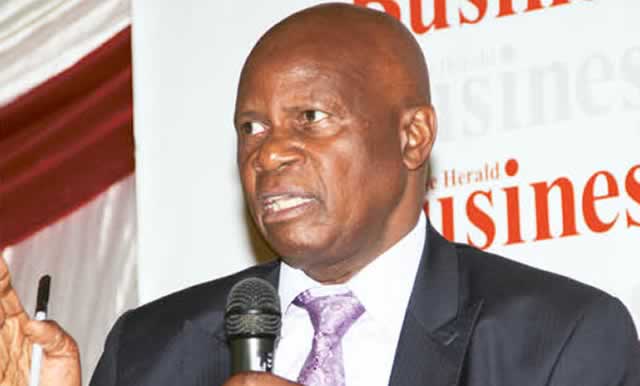2014 road to economic growth #Zim-Asset

Business Reporters
Very little is to be said of 2014 in terms of the economy. It was largely a year, which ends with a political climax. Cheap and long-term financing remained elusive for companies while aggregate demand and in tandem capacity utilisation continued to fall.
Because of this, inflation was mostly negative if you add in the rand factor and to the workers’ salaries were less regular. Companies closed while the Zimbabwe Stock Exchange lost some listings. There was a huge growth in the informal market mostly in vending as any open pavement and traffic lights became a market place.
The politics of the economy!
As Zanu-PF was due to hold its elective congress early this month, attempts to induce momentum in the economy by way of implementing Zimbabwe Agenda for Sustainable Socio-Economic Transformation (Zim-Asset) suffered major setbacks as factional politics within the ruling party took a centre stage ahead of congress.
While the real drama unfolded a few weeks before the congress, focus on the economy had shifted way back and this created uncertainty among businesses and investors.
Factional politics got in the way of investment deal approvals. It also was a major impediment in the implementation of the indigenisation laws.
In as much as Government puts forward clearly defined policies; the lack of proper guidelines for attaining economic growth, macro-economic dislocations, lack of continuity coupled with traces of political deception.
At the end of it all, Government managed to do away with two centres of power towards the end of the year with the sacking of several senior Government officials.
A renewed Government has to speak with one voice and be consistent with its policies. They should bring finality and closure on what they want to achieve with indigenisation, bearing in mind that this is not a concept new to Zimbabwe.
Trending for Government —
#Zim-Assetsong
2014 was the first implementation year of Government’s economic blueprint Zim-Asset. You can’t coin it on the Eversharp like what school children used to do to ESAP back in the day but you can be rest assured that everyone knows about it. Knowing about it to the point that every success story became an endorsement of the blueprint!
Government talked about it at every opportunity. It is supposed to stir the country forward at an average growth of 7,2 percent per annum. Structural reforms are required in order to make this blueprint successful.
Finance and Economic Development Minister Patrick Chinamasa said the economy should grow at 8 percent per annum for the next ten years if the country is to realise meaningful economic revival. He said GDP growth for 2014 was projected at 3,1 percent but the target could not be reached due to inherent liquidity shortages in the economy, coupled with low domestic savings, investment inflows and power supply deficits.
Minister Chinamasa said the projected 3,2 percent per annum growth for 2014 will not be enough for a robust economic revival. He said a stable macro-economic environment, coupled with planned investments in agriculture, mining, communication and other infrastructural projects, including power generation and housing, will among others, spur growth, forecast at about 3,2 percent for 2015.
Overall, the problem lies in linking up the vision with the reality on the ground and the first thing would be to identify the present state of the economy. The present state of the economy is none other than that of insignificant foreign direct investment and deep levels of collapse and degeneration of basic economic structures. And Government needs to be realistic about it.
What Zimbabwe needs is a cocktail of good fiscal and monetary policies in addition to local and foreign investment to jump start the economy. To stimulate local investments the Government’s fiscal policy should address savings and to increase savings the cash strapped Government should lower taxes.
In order to improve FDI inflows Government should address ease of doing business issues and IEE laws and regulations.
Parastatals took centre stage at the beginning of the year with the PSMAS salary scandal being the most significant. Salaries of chief executive were capped but this was never implemented due to the nature of the contracts. Finance and Economic Development Minister Patrick Chinamasa talked about reforming state-owned enterprises but this will only be reality next year following the setting up of a fund by the World Bank.
In 2014, a lot of grants and concessionary loans were signed with countries such as Sweden, Denmark, the European Union, the World Bank, the African Development Bank, Badea, Switzerland. The Staff Monitored Programme was extended with a successor programme having been okayed.
At the same time Government led by President Mugabe went on a trip to China where they unlocked commitment over various infrastructure deals. The Russians also came for the Darwendale Platinum project and expressed interest in Agriculture and Infrastructure. All this renewed momentum to the implementation of Zim-Asset.
Trending for companies — #RestructuringAndRationalisation
You can also add reconfiguration. It all adds to the same thing. High operating and finance costs continued to chew up the little revenue coming into the coffers.
The economy suffered from serious liquidity shortages, compounded by low domestic savings, elusive foreign direct investment, company closures and power shortages.
The performance of mostly consumer facing companies such as Delta and OK Zimbabwe reflected the continuing squeeze on disposable
incomes in a shrinking economy. Even when prices of goods generally declined, consumer expenditure has not grown.
The manufacturing sector continued to be weighed down by old equipment, shortage of working capital and high labour costs. According to CZI, capacity utilisation dropped 3,3 percentage points, from 39,6 percent in 2013 to 36,3 percent in 2014.
A survey conducted by the Zimbabwe Economic Policy Analysis and Research Unit found that 63 percent of the companies identified access to finance as a “major constraint” to growth, with prohibitive borrowing costs cited as one of the major reasons. It is for the reasons mentioned above that the buzzwords in corporates became — Rationalisation and Restructuring. Most of the companies undertook retrenchments while some downsized operations.
Nevertheless, there were some successful restructurings and reconfigurations. The re-opening of David Whitehead and the resilience of Cairns Holdings. Government is also making efforts to restore the central bank’s functions. RBZ welcomed a new governor Dr John Mangudya replacing Dr Gideon Gono. He has little to work with but in just seven months he has managed to set up bad-loans buying company ZAMCO and has also introduced bond coins. BancABC was bought by Atlas Mara for about $265 million in April in the company’s first African acquisition. Hwange is yet to show but they have also embarked on a re-organisation. Hwange Colliery finally appointed a substantive chief executive following the departure of Mr Fred Moyo in 2011.
The Atlas Mara deal however resulted in the Banc ABC group chief executive Mr Doug Munatsi along with group chief financial officer Mr Beki Moyo and group chief operating officer Mr Francis Dzanya stepping down from the regional financial group. Mr Howard Buttery also stepped down as chairman of the Board of Directors of BancABC and fellow director, Mr Ngoni Kudenga. Mr Munatsi and company were replaced by an Atlas Mara team led by Mr Simbarashe Ronald Pfende new group CEO and comprise of Ms Makhosi Boyede and Ms Amelia Reynecke, who are the co-chief operating officers, and Ms Christine Bronkhorst the chief financial officer. Atlas Mara CEO Mr John Vital was appointed interim chairman and Mr Bradford Gibbs, a member of Atlas Mara’s executive committee, also joined the bank.
Elsewhere former RioZim chief executive Mr Ashton Ndlovu was forced to resign because shareholders were not happy with his performance. He was replaced Mr Noah Matimba. At Innscor Africa, former chief executive chief executive Mr John Koumides was replaced by former board adviser Mr Antonio Fourie. Mr Jeremy Brooke left NatFoods Mr John Jere left Turnall Holdings and FBC sold out of the group through a dividend –in specie. Mr James Mushore left NMB on medical grounds while chair Mr Tendayi Mundawarara expressed his desire to leave the group at the next AGM.
In the banking sector ZB had a difficult year which forced it to wind down the operations of its stock-broking arm ZB Securities and asset management unit, ZB Asset Management Company and the cleaning up of its banking group’s loan book, and offloading at least 300 employees which put a huge dent on its profit and loss account resulting in it issuing a warning for an impending loss for the year.
The biggest restructuring or re-organisation failure is Cottco. When everyone thought that the company was on a recovery path following the recapitalisation funds from the unbundling of Aico, the market was shocked to learn that the company had applied for judicial management. However Cottco has since opted for a scheme of arrangement with creditors.
Public Relations disasters
Public Relations practitioners are there to help journalists get the correct information about an organisation. However there are some that have not been as good at this job and always make getting information most difficult for journalists. Here’s the worst of the lot:
Zimra – The PR Department believes that the media should be fed from crumbs packaged in a statement time and again. Who in this day and age still requests for a letter with a stamp and letterhead. Any request for information outside the quarterly updates are usually referred to the Revenue Authority Act [Chapter 23:11] and; “I am, therefore, unable to comment or provide the requested information ….”
RBZ—The Central Bank PR department is as good as non-existent. It does not respond to requests from the media and does not facilitate any interviews with the Governor.
Econet – Requests for comment on operational issues are often met with; “Econet Wireless is unable to comment on this matter at this time.”
Lafarge—Lafarge believes that media are lapdogs meant to cover only their corporate social responsibility programmes.
Potential headlines of 2015 and beyond
–Dawn and African Sun rebundle
–Hwange returns to profitability
–Gvt unveils +$1 bln Zim Asset funding
–Herald Business to host London Investment Conference
Dream Business Headlines for 2015 and beyond
—Samsung to open plant in Zimbabwe
—Zim gets $5 billion infrastructure grant from World Bank
—Zim overtakes Nigeria as Africa’s biggest economy
—ZSE chief executive under fire
—All set for NRZ’s speed train journey to Vic Falls
—CFI chief executive resigns
—McDonalds to open first branch in Harare
—Electricity supply at 5000MW exceeds demand
—Air Zim to fly to New York daily
—Zeco to delist from the ZSE
—Zimpapers finally holds analyst briefing









Comments